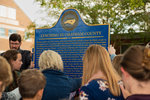

PITTSBORO — Along Moore Springs Bridge on what was once Raleigh Road, there’s a tree that holds memory. Its limbs cracked from bearing the weight, its soil forever stained by the blood of a lynching victim.
It is the tree where Eugene Daniel was lynched in Chatham County in 1921.
Trees across the county hold dark memories in their roots, too — in the names of Jerry Finch, Harriet Finch, John Pattishall, Lee Tyson and Henry Jones.
This was the premise of a poem by North Carolina Poet Laureate Jaki Shelton Green entitled “I Wanted to Ask the Trees.” She performed Saturday at the unveiling of a historical marker donated by the Community Remembrance Coalition-Chatham and the Equal Justice Initiative between Chatham County’s old Agricultural Building and Justice Center, not far south of the old county courthouse.
“I wanted to ask the trees,” Green said. “Do you remember? Did you refuse to hold his weight? Did your branches crackle? Did you refuse to hold him? Did you feed his blood to your roots?”
Green’s poem was one of several emotionally charged remembrances at Saturday’s marker unveiling. The ceremony also featured a letter to Daniel, who was lynched just days after his 16th birthday, from his great-great-great-nephew, Cameron Sanders.
“Dear Uncle Eugene,” Sanders’ letter read. “I guess what I really want you to know is that we have not forgotten you and if I am blessed to have a son, he will know your name and your story.”
Sanders, 19 and a student at Central Carolina Community College, and Daniel are separated by 97 years. Perhaps, Sanders said, if Daniel had been allowed to live and grow old then the two could’ve met.
“We acknowledged your life, that you were a teenager just like I am today,” Sanders said in his letter. “And that you did not deserve to die the way that you did.”
Sanders now lives less than three miles from Daniel’s former home on East Stone Road, but many of Daniel’s direct descendants moved away from Chatham County to escape the stigma of the tragedy and the trauma of his tragic death.
The legacy of Daniel, along with the other lynching victims in Chatham County, is now permanently etched into the county’s landscape. The vibrant blue marker with yellow lettering erected Saturday marks a dark history of injustice and intolerance.
It recounts the stories of each lynching, including that of Daniel:
“On September 18, 1921, a white mob lynched a 16-year-old Black boy named Eugene Daniel after he was falsely accused of assaulting a white girl. The mob took Eugene five miles east to an area near Moore’s bridge, hanged him with a chain, and shot his body repeatedly. The next day, at least 1,000 spectators came to view Eugene’s hanged remains. No mob participants were held accountable for lynching these Black men, women and children.”
The marker also tells the stories of the other five victims.
On September 28, 1885, a white mob of more than 20 men stormed Pittsboro’s jail on the suspicion that a group of Black Chatham residents had conspired to murder members of the Gunter family. The raid came after a coroner’s jury issued a report suggesting the four people were guilty of the murder. Court documents show the convictions made by the jury were largely hearsay from white witnesses. The men then abducted and lynched Harriet Finch, Jerry Finch, Lee Tyson and John Pattishall despite no evidence of their guilt. Later, their bodies were found hanging from trees less than a mile from the jail.
In 1899, Henry Jones was accused of raping and murdering a white woman named Nancy Welsh in Bear Creek. The day after Welsh’s body was found, a white mob of more than 50 men abducted Jones while he was sleeping in his home and lynched him.
The Chatham County lynching victims are part of the more than 120 who were killed by racial terror in North Carolina between 1865 and 1950.
The unveiling ceremony also featured remarks from prominent local officials including Congressman David Price, N.C. Senator Valerie Foushee and Chatham County Board of Commissioners Chairperson Karen Howard. Each representative shared the importance of recognizing the past in the work toward a more just future.
“Even a painful remembrance should be seen as an expression of our patriotism,” Price said. “There are three kinds of patriots — two bad and one good. The bad patriots are the uncritical lovers of their country and the loveless critics of their country. Good patriots carry on a lover’s quarrel with their country.”
He said this is the kind of patriotism Chatham was achieving through the unveiling of this marker because the county was recognizing its flaws and embarking on steadfast determination to amend those flaws. The congressman said he believes true patriotism requires honest history.
The ceremony continued with performances from local youth dance groups — the Ebone Soul Steppers and Chatham Dance Connection — as well as vocal performances from the Woods Charter School Choir.
Attendees of the ceremony were then led outside to the location of the new marker as the choir sang “This Land is Your Land” to the strums of a ukulele. The song of unity was written in 1831, 90 years before Eugene Daniel was lynched, but the choir chose the song as the background to the march toward the marker because of its sense of collective patriotism.
Once the crowd gathered around the new maker, CRC-C Co-coordinator Bob Pearson — who was instrumental in the four-year project to erect it — reminded everyone of the work that preceded Saturday’s unveiling.
“We are here today because history requires that this story be told,” Pearson said. “Others now and in the future can read this marker and learn and be inspired by it to continue to bring justice to our community.”
He said justice cannot be achieved without truth. The process of erecting the marker first began with the founding of the CRC-C four years ago by Pearson and Mary Nettles. Pearson said the CRC-C was meant to reconcile Black history in the county and seek a progressive way forward.
According to EJI, the Historical Marker Project erects narrative markers in public locations describing the devastating violence, today widely unknown, that once took place. These projects and the other engagement efforts that community coalitions develop center the African American experience of racial injustice, empower African American community members who have directly borne this trauma, and invite the entire community to use truth to give voice to those experiences and expose their legacies.
While marking the history of lynching has been the primary focus of the CRC-C, Pearson said this was just the first step.
One of the next steps Pearson said the CRC-C may devote energy toward is recognizing the enslaved Africans who were brought to Chatham County with European settlers. Currently, the Historical Museum in Pittsboro has a plaque of “the first settlers of Chatham County,” but Pearson said it includes only white European names.
He said another focus in creating a more just community is intentional growth — meaning providing new jobs to underserved communities. The county has more than $9 billion of economic development promised between the recently-announced VinFast and Wolfspeed projects, which have combined to pledge more than 9,000 new jobs here.
“We have a very bright future ahead of us,” Pearson said. “We have the ability to shape this community into a model of a just society and a just community here in Chatham County. We want not only economic development, but judicial development, scholastic development, social development, cultural development. We want to ensure people of color have access to these jobs too.”
Pearson said the community is on the right path for a brighter and more equitable future for all Chatham residents of past, present and future.
After the cover was lifted to reveal the marker, Howard formally accepted the gift from the CRC-C and EJI. She said it was a momentous occasion for the community.
“The thing that touches me most about this day is the faces in the crowd,” Howard said. “I know it is absolutely essential that we change institutional practices, but more than that we need to be changing the hearts and minds of people.”
She said the marker is a small step in healing and taking action toward a more anti-racist community. While reconciliation of the past is never a finished process, Howard said it begins with taking ownership of all aspects of our shared history.
“Wounds that are left to fester in dark moldy places don’t really heal,” she said. “We had wounds around lynching in Chatham County that were allowed to fester, shrouded in lies and darkness and secrecy of shame and we have exposed them.”
Howard said it would be more damaging to let the stories of these Black and brown people die in silence than to share these injustices with dignity and understanding. She said there is no shame in telling this history.
The unveiling ceremony concluded with participants placing a hand on the new marker, representing each member of the community being part of the living history in Chatham.
For more information about the marker visit www.eji.org/projects/community-historical-marker-project and to learn more about CRC-C visit www.crc-c.org
Reporter Ben Rappaport can be reached at brappaport@chathamnr.com or on Twitter @b_rappaport.